The holiday season approaches, and with it comes the perennial question—how to decorate our homes in ways that feel festive yet aligned with our everyday aesthetics? For 2025, minimalist Christmas decor continues its reign, but with fresh twists that honor both tradition and modernity. Gone are the days when holiday decorating meant cluttering every surface with figurines and tinsel.
I’ve spent the better part of a decade tracking interior design trends, and lemme tell you, this year’s minimalist holiday approach feels different. More intentional. More connected to what truely matters.
The Essence of Minimalist Christmas in 2025
Minimalism isn’t about having nothing—it’s about making room for the right things. The 2025 holiday season embraces this philosophy wholeheartedly, encouraging us to select fewer, more meaningful decorations that create maximum impact. This approach not only produces stunning visual results but also reduces the environmental footprint of our celebrations.
The psychological benefits cant be ignored either. Research consistently shows that decluttered spaces promote mental wellbeing, something we all need during the sometimes hectic holiday season. By embracing minimalist decor, we create sanctuaries that feel both festive and calming.
Many homeowners are finally realizing that “less is more” doesn’t mean “boring.” Instead, it opens up possibilities for thoughtful, intentional design choices that highlight quality over quantity. The result? Spaces that feel both celebratory and serene.
1: Sculptural Bare Branch Arrangements
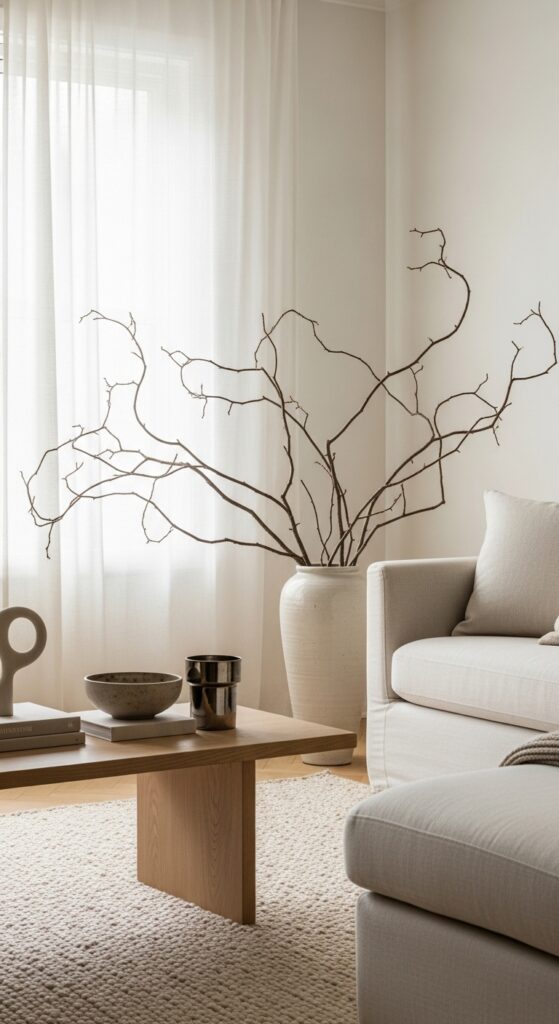
Nothing says minimalist nature quite like bare branches arranged in a striking vessel. Look for interesting shapes—asymmetrical branches with character work best. Simply place them in a neutral ceramic vase and position in a corner that needs height.
I’ve found that foraging these branches myself creates a deeper connection to the decor. Branches from birch, maple, or even fruit trees create different effects depending on your desired aesthetic. Some designers are even painting single branches in metalic finishes for 2025, but the all-natural look remains most popular.
2: Monochromatic Greenery Clusters

Rather than overwhelming your space with multicolored decorations, consider creating impact through monochromatic greenery groupings. Eucalyptus, pine, and olive branches clustered together create textural interest while maintaining color cohesion.
The trick is varying the textures while keeping the color palette tight. This approach works especially well in modern spaces with neutral foundations. Place these arrangements strategically—perhaps on a coffee table, mantlepiece, or dining table centerpiece—and resist the urge to scatter them throughout your home.
3: Single-Element Wreaths

Forget the overstuffed wreaths of years past. For 2025, the trend is toward single-element wreaths that make a statement through simplicity. A hoop with nothing but olive branches, a eucalyptus circle, or even a geometric wire form with just a few sprigs of greenery—these minimal interpretations feel fresh and sophisticated.
The beauty lies in the negative space. When displayed against a neutral wall or door, these wreaths create breathing room that traditional versions lack. Don’t be afraid to leave parts of the base visible—that intentional incompleteness is precisely what makes these modern interpretations so compelling.
4: Raw Wood Accents

Unfinished wood elements bring warmth and organic texture to holiday decor without overwhelming the senses. Think wooden candleholders, simple manger scenes carved from a single block, or raw-edge wooden chargers for holiday place settings.
I’ve been collecting small pieces all year, focusing on items with beautiful grain patterns or interesting natural edges. These elements introduce a tactile quality that softens minimalist spaces. Some of my clients have even commissioned local woodworkers to create custom pieces that can become family heirlooms—so much more meaningful than mass-produced decorations.
5: Intentional Lighting Constellations
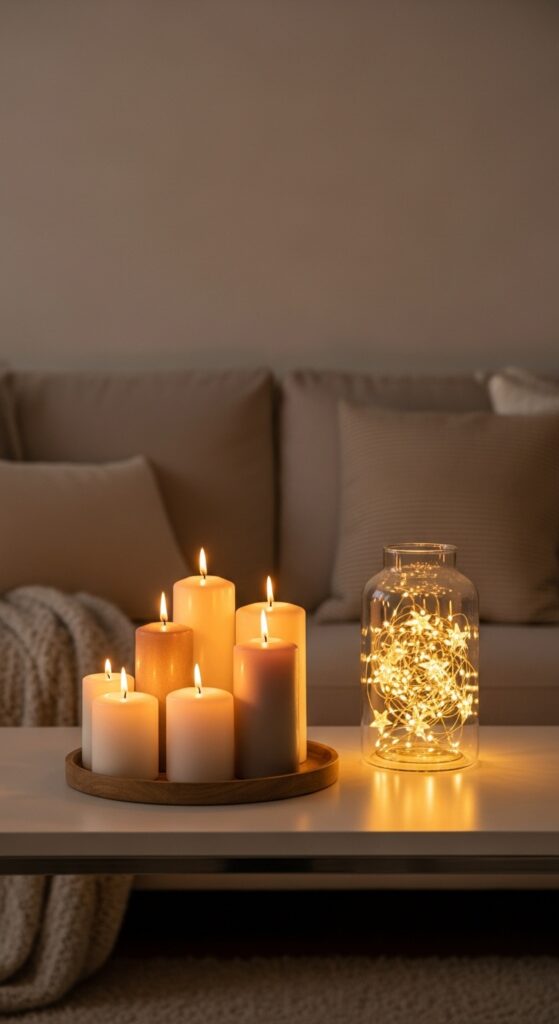
Lighting makes or breaks holiday ambiance, and 2025 sees a move toward what I’m calling “lighting constellations”—thoughtful arrangements of candles or tiny string lights that create patterns rather than blanket coverage.
Group pillar candles of varying heights on a simple tray. Or thread delicate wire lights through a large glass vessel. The effect should be one of quiet drama, not overwhelming brightness. I’ve been advicing clients to create these arrangements at different heights throughout a room, allowing the eye to travel between these gentle pools of light.
6: Shadow-Casting Luminaries
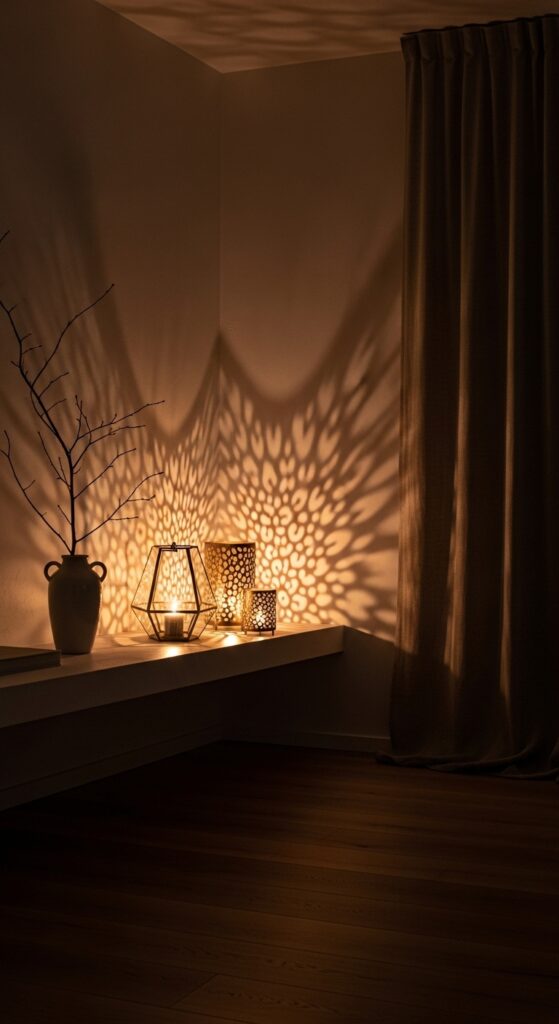
Some of the most beautiful holiday lighting comes not from the light source itself but from the shadows it casts. Paper-cut luminaries, metal filigree lanterns, or even simple glass hurricanes with geometric cutouts can transform a plain wall into a canvas of dancing light.
These pieces work double duty—they’re beautiful objects during daylight hours and magical shadow-casters after dark. Position them near walls to maximize the shadow effects. My favorite this season is a set of brass geometric forms that cast incredible patterns across my living room walls.
7: Focused Window Lighting
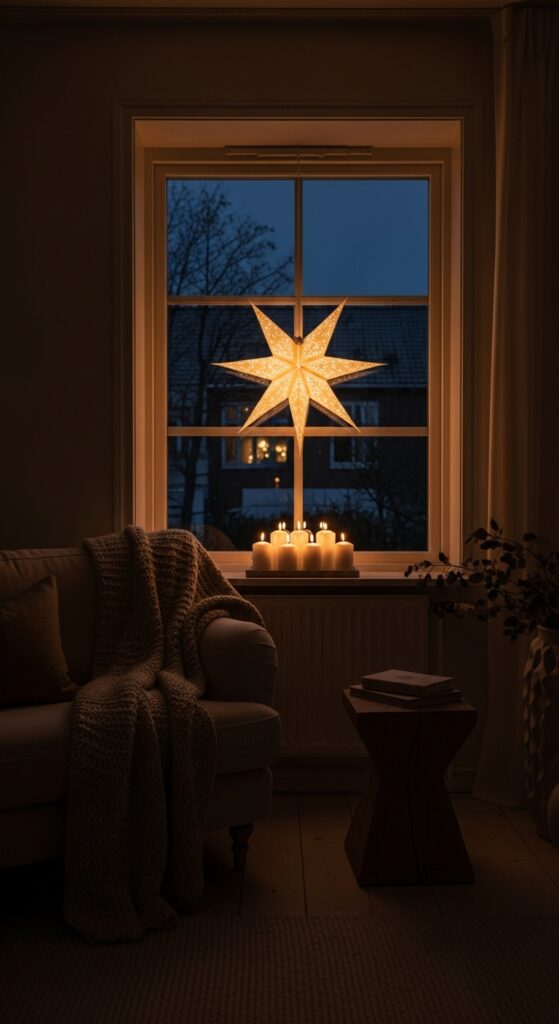
Rather than stringing lights across every available surface, 2025’s minimalist approach concentrates light in key areas—particularly windows. A single oversized star light, a carefully arranged grouping of pillar candles, or a striking paper-cut scene silhouetted against the glass creates drama visible both inside and out.
This approach honors the historical tradition of lighting windows to guide travelers home during dark winter nights. The contrast between the illuminated window and the surrounding darkness creates a focal point that’s both meaningful and beautiful. Plus, this lighting strategy makes you’re home look amazing from the street without having to climb up on the roof!
8: Winter White Palette
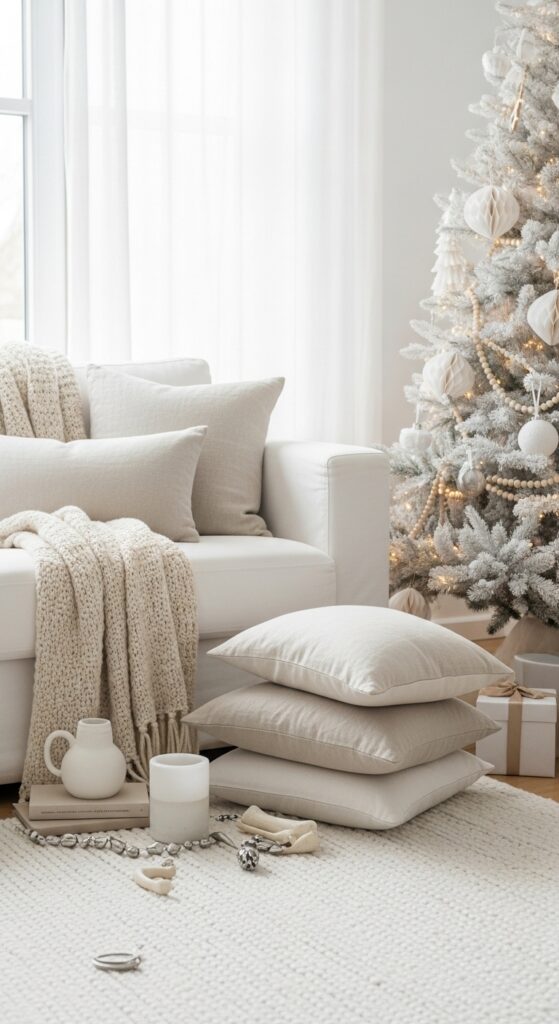
White-on-white arrangements create a sense of peaceful winter wonderland without the commercial Christmas color associations. Layer different shades and textures of white—creamy wools, bright porcelain, soft papers, and matte ceramics—to create depth within this restrained palette.
This approach works especially well in already-neutral spaces, where it feels like a natural extension of the existing design. The beauty comes through subtle variations rather than stark contrasts. Sometmes I’ll add just the tiniest hint of silver or natural wood to prevent the scheme from feeling flat.
9: Earthy Terracotta and Sage
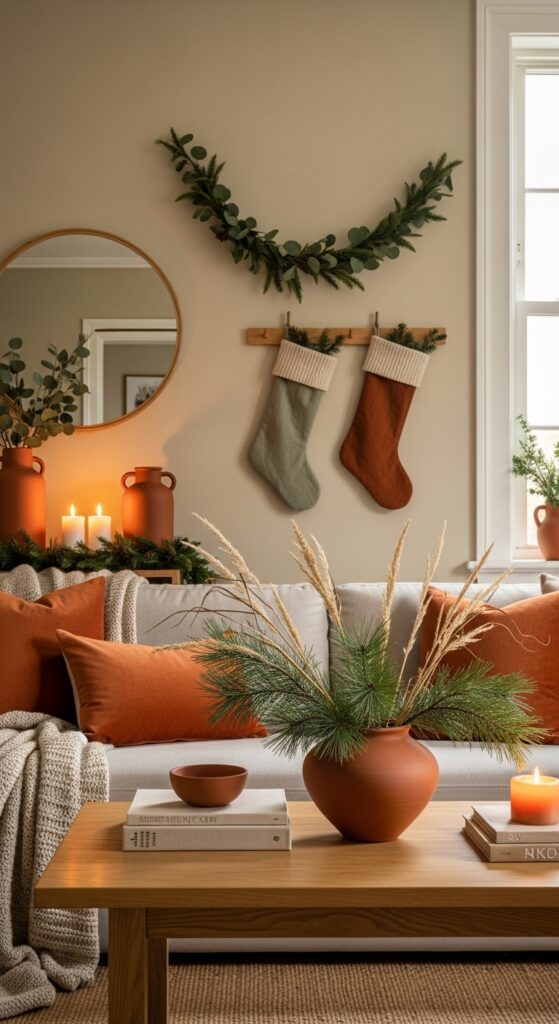
For those seeking alternatives to traditional red and green, 2025 offers sophisticated earthy palettes. Terracotta, sage, and mushroom tones create a festive feeling that’s connected to nature without screaming “Christmas.”
These colors transition beautifully from fall through winter, making them practical choices for extended seasonal decorating. I’m particularly fond of sage green paired with unglazed terracotta for a combination that feels both current and timeless. These colors also complement most existing interior palettes without requiring a complete design overhaul.
10: Black Accents for Drama
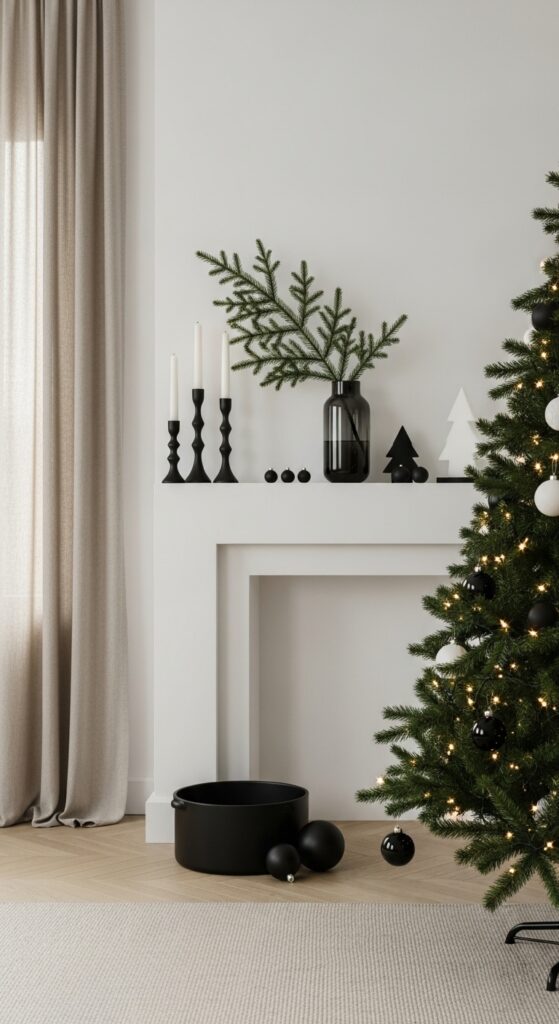
For the truly minimalist approach, consider incorporating black accents against neutral backgrounds. Black candlesticks, matte black ornaments, or even black branches create striking silhouettes that feel decidedly modern while maintaining festive spirit.
The key is using black sparingly as a punctuation rather than a dominant element. These dark moments create visual anchors in otherwise light spaces. I’ve been using slim black tapers in simple holders, grouped in arrangements of odd numbers for maximum impact this season.
11: Foraged Natural Elements
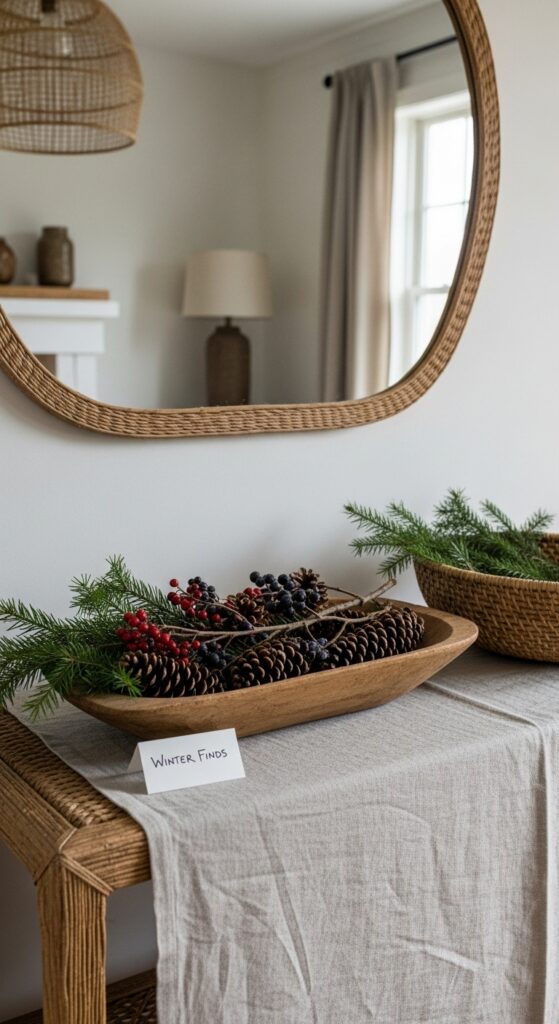
The most sustainable decorations come from your own environment. Pinecones, acorns, interesting seed pods, and evergreen sprigs gathered on walks create displays with zero carbon footprint and genuine connection to your local landscape.
Arrange these elements simply—a bowl of pinecones, a line of acorns along a mantel, or evergreen sprigs tucked into napkin rings. The beauty of these arrangements comes from their honesty and imperfection. My family has made collecting these elements part of our holiday tradition, with each person bringing something natural to add to our central display.
12: Biodegradable Paper Decorations
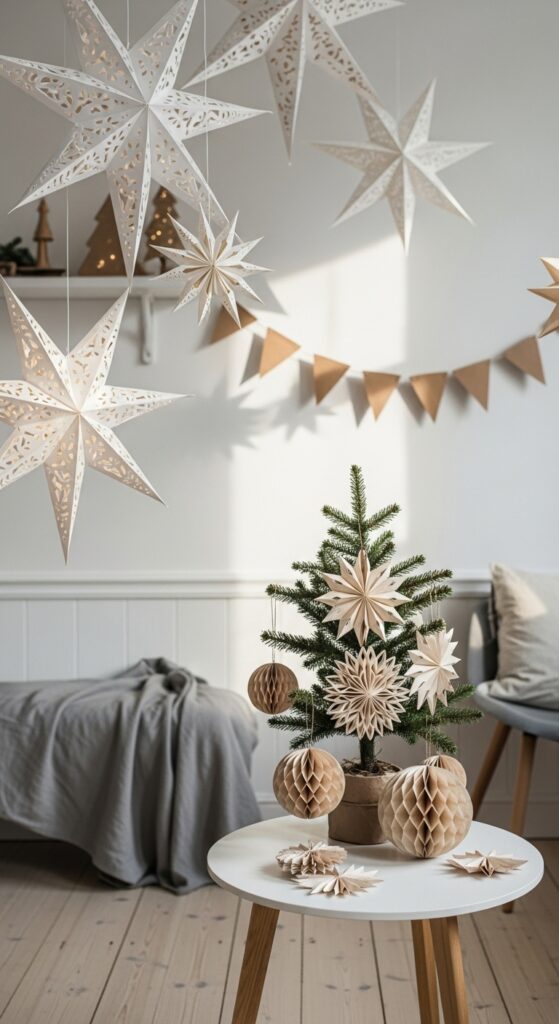
Paper decorations have made a significant comeback, particularly those made from recyclable or biodegradable materials. Delicate paper stars, honeycomb balls, and intricately cut snowflakes create visual interest without environmental guilt.
These can be purchased from sustainable sources or, better yet, handmade during holiday gatherings. The act of creating becomes part of the celebration itself. We hosted a paper-cutting party last December that produced the most beautiful collection of unique decorations—far more special than anything store-bought.
13: Repurposed and Upcycled Ornaments

Sustainability meets creativity in the trend toward repurposed decorations. Old book pages folded into stars, fabric scraps transformed into simple ornaments, or vintage items given new life as holiday decor align perfectly with minimalism’s waste-reduction ethos.
These pieces often carry stories and memories that mass-produced decorations lack. I’ve been collecting mismatched vintage silverware throughout the year to create place settings that feel special without being overtly themed. These items will return to everyday use after the holidays, embodying the practical side of minimalism.
14: Minimalist Tree Alternatives

Traditional Christmas trees receive the minimalist treatment in 2025 with several compelling alternatives. A simple branch arrangement in a large vessel, a wall-mounted wooden outline, or even a geometric metal framework can serve as modern interpretations of the classic tree.
These alternatives require fewer ornaments, take up less space, and often can be stored more easily than traditional trees. For apartment dwellers or those with limited storage, these options offer festive feeling without the logistical challenges. My favorite this year is a simple wooden ladder-like structure that leans against the wall, with just a few special ornaments hanging from its rungs.
15: Restrained Mantel Styling

The mantelpiece often becomes overly crowded during holiday decorating. The minimalist approach instead embraces negative space, perhaps featuring a single statement garland or an asymmetrical arrangement anchored on one end of the mantel.
This restraint actually highlights architectural features rather than obscuring them. In my own home, I’ve placed three varying heights of beeswax candles on one side of the mantel, balanced by a simple branch arrangement on the other, with plenty of breathing room between. The effect is both festive and calming.
16: Table Settings with Natural Minimalism

Holiday meals deserve special settings, but minimalism suggests quality over quantity in tableware too. Consider a simple linen runner down the center of the table, individual sprigs of greenery at each place setting, and matte stoneware in neutral tones.
The overall effect should be welcoming rather than fussy. These understated settings actually encourage focus on the food and conversation rather than elaborate decorations. I’ve found that even just adding a small sprig of rosemary to each napkin brings a festive element without overwhelming the table.
Implementing These Ideas: The Minimalist Approach
When applying these ideas, remember that minimalism isn’t just about aesthetics—it’s about intentionality. Start by clearing away regular decor items to create a clean foundation. Then add holiday elements thoughtfully, giving each piece room to breathe.
Group similar items together rather than scattering them throughout your space. This creates focal points that draw the eye and prevent the scattered feeling that often accompanies holiday decorating. Three pinecones grouped on a shelf make more impact than one pinecone in three different locations.
Consider your home’s existing color palette and architecture when selecting holiday elements. The most successful minimalist decorating feels like a natural extension of your space rather than a temporary overlay. In my brick-walled loft, I’ve choosen to emphasize terracotta and natural elements that complement rather than compete with the existing materials.
The Emotional Impact of Minimalist Celebrations
Perhaps the greatest benefit of minimalist holiday decor lies not in its appearance but in its emotional effect. By simplifying our surroundings, we create space for what truly matters—connection, reflection, and presence.
Many of my clients report feeling less stressed and more able to enjoy the season when they embrace minimalist decorating principles. Without the pressure to transform every inch of their homes, they find more time for meaningful activities. The visual calm of minimalist spaces seems to translate into emotional calm as well.
This approach also allows special items to shine. When not competing with countless other decorations, heirloom pieces or handmade items receive the attention they deserve. In my family, we’ve started displaying just one special ornament from each person’s collection rather than dozens, allowing us to share the stories behind these chosen pieces.
The Future of Holiday Decorating
As we move toward more sustainable and intentional living practices overall, holiday decorating will likely continue to evolve in this direction. The excesses of previous decades feel increasingly out of step with contemporary values around consumption and environmental impact.
The 2025 approach represents not just a aesthetic shift but a philosophical one—toward celebrations that honor tradition while embracing modernity, that feel special without requiring excess, and that create atmosphere without unnecessary consumption.
By choosing quality over quantity, meaning over obligation, and intention over habit, we create holiday environments that truly nurture us. That, perhaps, is the greatest gift we can give ourselves and our loved ones during this season—spaces that allow genuine connection to flourish.
The minimalist Christmas isn’t about having less for the sake of austerity. It’s about making room for what matters most. And isnt that what this season is supposed to be about anyway?

Mariana is the founder and voice behind Home Nookery, a curated blog dedicated to home design, décor inspiration, and cozy living. With a passion for creating beautiful, functional spaces, Mariana shares practical tips, styling ideas, and thoughtful insights to help readers turn their houses into homes. Whether you’re redesigning a room or just adding a touch of charm, she’s here to guide you with creativity and heart.
